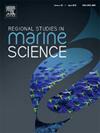Freshwater plume’s impact on the thermohaline structure of the water column in the Central Zone of the Strait of Magellan
IF 2.1
4区 环境科学与生态学
Q3 ECOLOGY
引用次数: 0
Abstract
The Strait of Magellan, a sub-Antarctic channel connecting the Pacific and Atlantic oceans, is divided into three zones based on oceanographic and meteorological characteristics: Eastern, Central, and Western. The Central Zone is influenced by strong northwesterly winds and freshwater inputs from rivers and precipitation, making it crucial to understand its thermal and haline dynamics in response to these forcings. This study examines the seasonal variability of temperature and salinity in the water column at a fixed station in the Central Zone from 2018 to 2022, analyzing key environmental drivers. A detailed assessment of absolute salinity fluctuations in the upper layers was conducted using ocean reflectance from Sentinel-2 satellite data, river discharge, and wind dynamics, modeled with a generalized additive model incorporating delayed effects. Results reveal a seasonal surface temperature pattern, increasing in summer and decreasing in winter due to solar radiation. In winter, the surface layer remained relatively uniform, while summer conditions led to thermal stratification driven by intense solar heating. A winter thermal inversion was observed, attributed to reduced solar radiation and the vertical intrusion of warmer Modified Subantarctic Water from the Pacific. Surface salinity exhibited a seasonal cycle, with lower values and stronger stratification in winter due to freshwater discharge and wind-driven advection of the river plume toward the study site. In contrast, deeper layers remained relatively homogeneous in temperature and salinity, influenced by Pacific-origin Modified Subantarctic Water. Climate change-driven shifts in these forcings could alter the water column structure, impacting ecosystem functioning and Indigenous communities reliant on marine resources. This study provides essential insights into the thermal and haline dynamics of the Central Zone, supporting marine biodiversity management and conservation efforts in the region.
求助全文
约1分钟内获得全文
求助全文
来源期刊

Regional Studies in Marine Science
Agricultural and Biological Sciences-Ecology, Evolution, Behavior and Systematics
CiteScore
3.90
自引率
4.80%
发文量
336
审稿时长
69 days
期刊介绍:
REGIONAL STUDIES IN MARINE SCIENCE will publish scientifically sound papers on regional aspects of maritime and marine resources in estuaries, coastal zones, continental shelf, the seas and oceans.
 求助内容:
求助内容: 应助结果提醒方式:
应助结果提醒方式:


